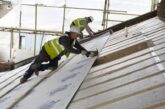
Professional Builder continues its sustainability focus with a look at Part ‘O’ of the Building Regulation. Recticel explains more.
Due to be effective from June, Part ‘O’ of the Building Regulations relates to overheating in properties and focuses on the need to uphold the health and wellbeing of occupants. The new regulation aims to limit instances of high indoor temperatures in new-build residencies by mitigating unnecessary solar gains in summer whilst ensuring there is provision to remove excess heat from the property where required. So, does insulation have a part to play in the cooling process?
Part ‘O’ is a response to concerns that with designers being urged to create properties of ever-greater airtight performance in order to improve thermal efficiency, buildings are overheating due to a lack of proper air regulation. With solar gain being a major contributor to indoor temperature increase, the regulations outline a number of fixed shading measures which should be used to offset it. These include shutters, external blinds, overhangs and awnings. Glazing design is also highlighted as a consideration to reducing overheating risk, with window-size, orientation and g-value (the rate at which glass transmits solar heat) being cited as important to the specification process.
Non-passive solution to staying cool
Part ‘O’ regulations state that ‘as far as reasonably practicable’ the standard should be achieved using passive means. Insulation falls into that category and is proven to prevent heat escape in colder months, particularly when installed as part of fabric-first building design. To a certain extent, quality insulation will also negate heat entry into a property. However, on its own it will not be enough to combat uncomfortable temperature increases caused by excessive solar gain. This is why Part ‘O’ recommends non-passive interventions in the form of mechanical cooling and ventilation systems are used to reduce heat build-up and meet regulations. However, it stipulates that such interventions should only be seen as a secondary solution to other passive measures including open windows and exterior ventilation louvres.
Although not the ultimate solution to the overheating issue, quality insulation remains integral to creating energy-efficient homes and with it, reducing CO2 emissions. According to a 2021 report by the Environmental Audit Committee (EAC), energy inefficiency meant the UK’s housing stock accounted for 20% of the country’s greenhouse gases. Poorly insulated walls, ceilings and roofs are a major cause of fuel usage in counteracting the resulting energy escape.
It’s important, therefore, that the risk of overheating is not a barrier to achieving a thermally efficient home. Properties can be airtight and breathable, it just requires a degree of common sense and utilising natural ventilation where required, such as opening windows, to prevent rooms from overheating in summer months. Otherwise, costly and energy-consuming mechanical ventilation systems will impact our homes’ sustainability by neutralising the insulation’s effect in creating a comfortable interior climate throughout all four seasons.







